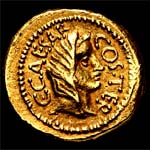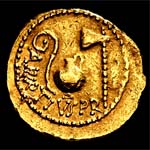
Before Giulio Cesare, Rome minted gold coins in irregular way. A first issue, called gold of the oath, was issued around the 220 BC following the characteristics of the Greek quadrigatus; the weight was of 6 scrupulum, corresponding to 6,82g. The name comes from the scene on the reverse of two warriors swearing on a piglet held by a third warrior, remembering the Roman victory on the Sannitis near Sentinum in 295 BC and the oath of fidelity following the peace in 290 BC.
A second gold series, named as "Mars/eagle", was coined in 209 BC with a weight of 3, 2 and 1 scrupulum. A third series was the one issued in Greece in 197 BC to celebrate the consul Titus Quinctius Flamininus, equivalent to a stater with the weight of around 8g.
The first aureus in the Roman monetary system (denarius aureus) was minted at the time of the war of Silla against Mitridate (88-85 BC), with a weight equal to 1/30 of the Roman pound (10,8 g) and presumable origin of the gold from the war booty.


As fractions of the aureus there was the quinarius (equal to half aureus) and the relationship between gold and silver was of one aureus against 25 denarii. As multiple there was the quaternione, equal to 4 aurei.
In the 61 a.C., during the government of Pompeo, the weight of the aureo was brought to 1/36 of the pound (around 9 g).
The regular minting of Roman gold coins, however, begins only after the conquest by Caesar of the Gallia and the availability of gold coming from its mines. In the 48 BC, under Caesar ruling, the weight of the aureus was initially fixed to 1/38 (8,55g) and then to 1/40 of pound (8,02g). This value was maintained stable for the whole period of the civil wars, up to the principality of Augustus.
The mass of the aurus decreased to 1/45 of pound with the monetary reform of Nero and with the reform of Caracalla the weight was further reduced to 1/50 of pound.
The end of the aurus took place in 309 with the introduction of the solidus by Costantine I as gold coin. While the solidus was thinner and of greater diameter than the aureus, the aureus was similar to the denarius in size, often sharing the same types.